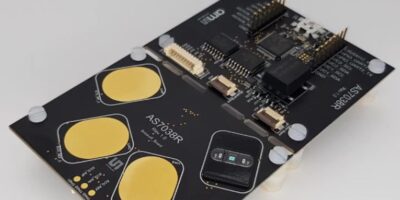Mouser adds ams’ blood oxygen monitoring for wearables
A thin sensor from ams, which brings blood oxygen monitoring capability to wearable devices, has been added to Mouser’s portfolio. The AS7038RB SpO2 sensor integrates photodiode, filter and signal processing and is just 0.65mm thick.
The sensor also includes electrical circuitry for concurrent ECG measurement and can be used to detect early symptons of Covid-19.
Claimed to be the industry’s thinnest dedicated sensor for blood oxygen saturation (SpO2) measurement, the AS7038RB is small enough to bring the capability to remotely monitor blood oxygen to small wearable devices such as ear buds, smart watches and wristbands, as well as to medical devices, patches and oximeters.
It is also suitable for remote diagnostic equipment, such as disposable patches used for SpO2 and electro-cardiogram (ECG) measurement in hospital emergency rooms. Using them allows medical teams and patients greater flexibility to choose how, where and when measurements of these vital signs are taken using non-invasive methods for fast response.
The AS7038RB integrates a photodiode, four LED drivers, an analogue front end, and a sequencer, all housed in a package with a footprint of 3.70 x 3.10mm and which is just 0.65mm thick. It is supplied with application software for SpO2 and heart rate measurement. The analogue front end also supports concurrent ECG measurement complying with the requirements of the IEC 6060-2-47 medical standard.
The accuracy of the AS7038RB’s SpO2 measurements, closely matches the outputs from medical-grade pulse oximeters used in hospital testing facilities, said Mouser. This is in part due to the on-wafer interference filter technology developed by ams. The filter enables the AS7038RB to capture optical signals in the 590 to 710nm and near infra red (800 to 1050nm) wavelength bands of interest for SpO2 measurement, while blocking interference from ambient light at other wavelengths. Combined with ams’ high-sensitivity photodiode, which has a large light-sensitive area of 2.5mm2 , a very high optical signal-to-noise ratio is produced, explained Mouser.
There is also provision for drivers for up to four external LEDs for flexibility in LED placement. LEDs can be positioned where they can be optimised for the different skin thicknesses and bone structure at the wrist, chest, forehead or finger, for example. The sensor’s high sensitivity and high signal-to-noise ratio enable it to operate effectively with a low optical power output from the LEDs. The integrated LED drivers provide for adjustment of the drive current, so the OEM can balance system power consumption and measurement performance, helping to extend run-time between battery charges in devices such as ear buds, which contain a small battery power source.




